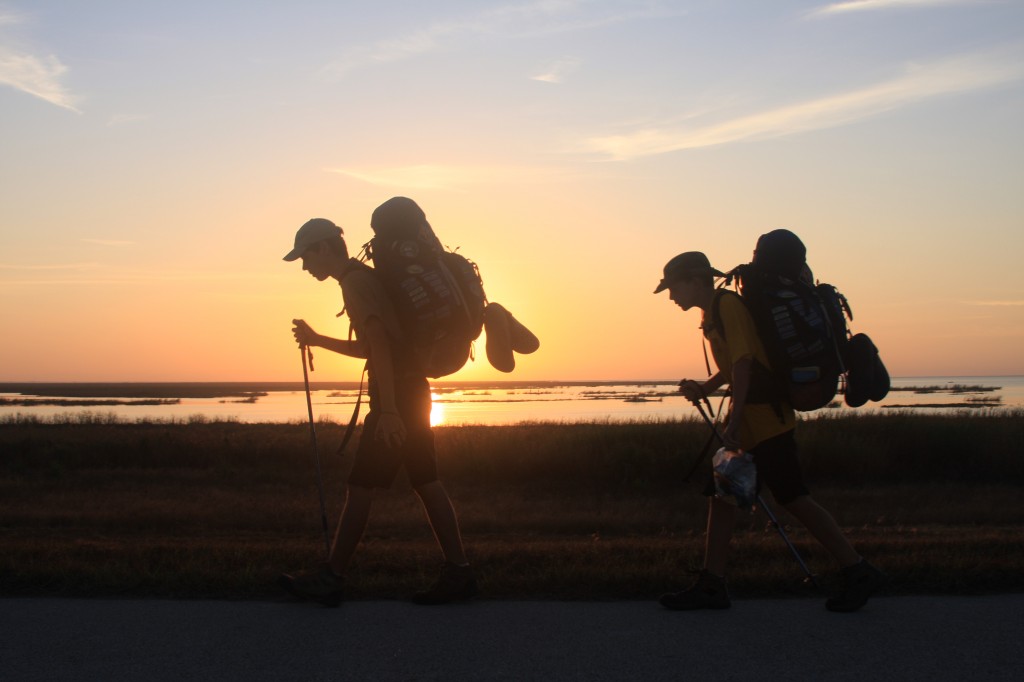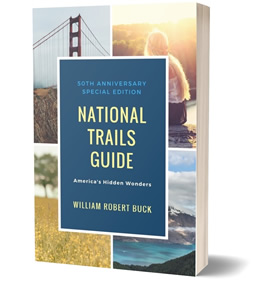The National Trails System is a world-class network of Congressionally-designated trails which span the United States. The Appalachian Trail, Pacific Crest Trail and similar national trails attract many outdoor enthusiasts, some of whom make plans to hike the entire length of the trail. These individuals are called thru-hikers. Our National Trails Guide site continues its thru-hiker blog series with a family who recently completed the entire Florida National Scenic Trail. These thru-hikers are an inspiration for parents and grandparents who want to introduce young people to our National Trails.
This Florida family, a father and two sons, have been walking the Florida Trail since 2010 (while mom has served as their transport and Trail Angel). This year, as they finished their last 380 miles of the trail, the boys (now 16 and 12) share the family pride in completing the trail. Congratulations to them!
1. How/when did you develop your love of hiking?
Zack and I headed out on his first (& my second) hiking trip to the Kissimmee River State Park for a two-day 6 mile trip. Looking back, we had so much junk in our packs because we thought we needed so much more than we really did and our packs weighed a ton. We look back at the pictures and we look like two nomads wandering the woods. Since then we have made multiple hikes every year, slowly upgrading a piece of equipment each year.
2. What National Trails have you hiked?
The boys and I have hiked a couple of sections of the Appalachian Trail in the Great Smokey Mountains National Park and after several years of section hiking we have now successfully completed the 1100-mile Florida National Scenic Trail, which makes both boys the youngest to complete the entire trail!
3. What were some of the motivations that drove you to take on a long distance thru-hike?
One day we were running a little low on water with no listed sources coming up, but it was supposed to rain that day so we came up with a plan to gather rain water. Our plan was that Zack would sit cross-legged with his rain poncho on and his arms held forward as if they were on the arm rests of a chair. We would allow the rain to channel into a container, then filter the water from there into our camel packs. Prior to the rain starting we were able to find an unlisted water source, so we filled up without needing to use our ‘Zack rain-catcher system!’
Our most common everyday challenge is the motivation/energy drop we experience a couple of hours after lunch. For this I always bring along 1 inch jaw breakers which I used to buy at Cracker Barrel. These are perfect for hiking because they don’t go bad or crush, and they last around 30 minutes or more, giving the boys just enough sugar to bring up both their motivation and energy. We’ve gone through so many jawbreakers over the years with multiple trips that I finally broke down, found a bulk distributor and split a 20 pound box of jaw breakers with my friend Chuck and his son.
We quickly found ourselves hiking through seven foot high grass with no trail in sight. Many times I would have to scout ahead to find an orange blaze indicating the Florida Trail, then have the boys hike to me; then I would scout ahead again for the next blaze. This five mile section was very slow moving, but it was not until the last half mile that things really got challenging. We came upon a section of trail that had been logged and was fully overgrown with briars which cut up our ankles and legs, and there was nowhere to sit for a break on a pretty hot day. At one point I turned around to see Cody in tears, almost to the point of giving up, but even he could see that giving up was impossible because we had just as far ahead of us as behind us and there was no way to get out without pushing through. Zack did an amazing job helping me try to keep him motivated and it took us nearly an a hour to cover that last half mile.
After all was said and done, Zack and Cody both state that they would never hike that section again (unless it’s been cleared), but they are still glad they hiked it rather than walk around on the bypass road. They said it helped them feel more like real hikers to make it past such a hard portion of the trail.
My new phone is a smart phone which I still keep shut off, only turning it on at camp to send messages. Usually I stick to text only, because my wife can send messages out at various times of the day and they will float around in cyberspace until I turn my phone on when I’ll get all the messages, if I can find a signal. I will only make voice calls if I have a very strong signal or else the battery will drain too fast as it searches for a stronger signal. With the new smart phone I am able to retrieve my own weather forecast and I carry a Joos Orange Solar Charger to keep it charged. The solar charger will give me two full charges on my phone if we have no sun, but I will hang the solar charger off the back of my backpack so it can charge as we walk.
I also never head out on a trip without my SPOT Emergency GPS Transmitter. At the end of each day I send out a signal to let my wife and a few other friends know our current location so that if something happens there will be a record of our progress. The SPOT also has an emergency button to notify rescuers in case of a life threatening emergency. We have been fortunate not to have to use the emergency feature, but it is nice to have, especially if we had been trapped by any flash floods.
11. What have been the challenges/rewards of taking children on a long distance hike?
The biggest challenge with kids on a long distance hike is keeping their motivation up and not over working them. I’m constantly listening to them talk to each other and watching their body language as we hike to judge their physical and mental motivation level. Like any kid, they like to ask how far have we walked and how much farther do we have to go. Most of the time I tell them I’m not going to give constant updates on mileage because it will seem to take forever to make it to our next campsite. They know that we will walk for a minimum of one mile before we take each break (several times they will go farther now that they are older) so they can keep track of the miles on their own if they want. Their mental motivation is the most important to keep track of because they can hike much farther than they realize as long as their spirits are high and they have a good conversation going.
Many rewards come from watching the boys experience something new: everything from getting our own personal tour of the Buckman Lock to seeing a hawk fly full speed through the woods and grab a snake off a branch about 10 feet in front of us. I also love to see the boys’ confidence level in their abilities. In camp I used to go to work setting everything up and cooking dinner as the boys played and climbed trees. I eventually had them setting up the tent along with a few other minor chores. They often ask me if they can do other things around camp, such as set up the bear rope, or get the cook stove set up. Last season I asked Zack to set up the tent as Cody and I headed off to filter some water for dinner. When we returned I found Zack sitting in the middle of our camp. The tent was fully assembled, all our gear was inside, the bear rope was hung, and our food was sitting next to the camp stove just waiting for water. Even though I would not have him do it now, I feel confident that Zack, at 15 years old, could successfully hike for a week on his own.
12. Do you have any suggestions to improve the thru-hiker experience on National Trails?
We currently live in Orlando, FL where I started each of the boys out hiking when they were around 8 years old. At this age they were each able to carry some of their basic gear (water, clothes, and sleeping bag). We started off hiking mostly State Parks in Florida, Georgia, and TN, hiking to their primitive campsites on one or two day hikes with the mileage around 3 miles a day.We began hiking the Florida Trail two years ago with the hope of completing it in 3 years. Today Zack is 15 and Cody is 12 years old and they have increased their mileage to 10-14 miles per day. My daughter Hannah has just turned 9 years old and she is looking forward to starting her hiking adventures with us next year, when we will go back to the State Parks for those lower mileage trips to get her started.
After completion of the Florida Trail, both boys now know that they can set a large goal ahead of them and as long as they keep working at it, little by little, they can accomplish anything. At the time of completion Zack was 16 and Cody 12 years old, which has made them the youngest people to complete the entire Florida National Scenic Trail!

